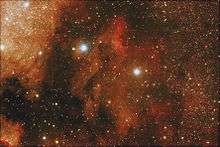Pelican Nebula
The Pelican Nebula (also known as IC 5070 and IC 5067[1]) is an H II region associated with the North America Nebula in the constellation Cygnus. The gaseous contortions of this emission nebula bear a resemblance to a pelican, giving rise to its name.[1] The Pelican Nebula is located nearby first magnitude star Deneb, and is divided from its more prominent neighbour, the North America Nebula, by a molecular cloud filled with dark dust.
| Emission nebula | |
|---|---|
| H II region | |
 Pelican Nebula (IC5070 and IC5067) | |
| Observation data: J2000.0 epoch | |
| Right ascension | 20h 50m 48.0s |
| Declination | +44° 20′ 60.0" |
| Distance | 1,800 ly |
| Apparent magnitude (V) | 8.0 |
| Apparent dimensions (V) | 60' x 50' |
| Constellation | Cygnus |
| Designations | IC 5070 and IC 5067 |
The Pelican is much studied because it has a particularly active mix of star formation and evolving gas clouds. The light from young energetic stars is slowly transforming cold gas to hot and causing an ionization front gradually to advance outward. Particularly dense filaments of cold gas are seen to still remain, and among these are found two jets emitted from the Herbig–Haro object 555.[1] Millions of years from now this nebula might no longer be known as the Pelican, as the balance and placement of stars and gas will leave something that appears completely different.
References
- Nemiroff, Robert; Jerry Bonnell (2011-11-26). "Astronomy Picture of the Day - Pelican Nebula Close-up". Retrieved 26 November 2011.
designated IC 5067
External links
![]()
- APOD Pictures:
- Pelican Nebula Close-up
- North America and the Pelican
- Nebulae in the Northern Cross
- IC 5067 in the Pelican Nebula
- Northern Cygnus